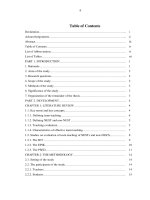Luận văn thạc sĩ VNU ULIS evaluation of team teaching in an english course at faculty of tourism, hanoi open university
Bạn đang xem bản rút gọn của tài liệu. Xem và tải ngay bản đầy đủ của tài liệu tại đây (167.64 KB, 4 trang )
1
VIETNAM NATIONAL UNIVERSITY, HANOI
UNIVERSITY OF LANGUAGES AND INTERNATIONAL STUDIES
FACULTY OF POST-GRADUATE STUDIES
------------
NGUYỄN THỊ THẢO
EVALUATION OF TEAM TEACHING
IN AN ENGLISH COURSE
AT FACULTY OF TOURISM, HANOI OPEN UNIVERSITY
(ĐÁNH GIÁ VIỆC GIẢNG DẠY THEO NHÓM
TRONG MỘT KHÓA HỌC TIẾNG ANH
TẠI KHOA DU LỊCH, VIỆN ĐẠI HỌC MỞ HÀ NỘI)
M.A. Minor Programme Thesis
English Teaching Methodology
60 14 10
HANOI – 2010
LUAN VAN CHAT LUONG download : add
2
VIETNAM NATIONAL UNIVERSITY, HANOI
UNIVERSITY OF LANGUAGES AND INTERNATIONAL STUDIES
FACULTY OF POST-GRADUATE STUDIES
------------
NGUYỄN THỊ THẢO
EVALUATION OF TEAM TEACHING
IN AN ENGLISH COURSE
AT FACULTY OF TOURISM, HANOI OPEN UNIVERSITY
(ĐÁNH GIÁ VIỆC GIẢNG DẠY THEO NHÓM
TRONG MỘT KHÓA HỌC TIẾNG ANH
TẠI KHOA DU LỊCH, VIỆN ĐẠI HỌC MỞ HÀ NỘI)
M.A. Minor Programme Thesis
Major: English Teaching Methodology
Code: 60 14 10
Supervisor: NGUYỄN TUẤN ANH, M.A.
HANOI – 2010
LUAN VAN CHAT LUONG download : add
6
Table of Contents
Declaration…………………………………………………………………………... i
Acknowledgements………………………………………………………………….. ii
Abstract……………………………………………………………………………… iii
Table of Contents……………………………………………………………………. iv
List of Abbreviations………………………………………………………………...
vi
List of Tables………………………………………………………………………...
vii
PART 1. INTRODUCTION………………………………………………………… 1
1. Rationale…………………………………………………………………………..
1
2. Aims of the study…………………………………………………………………. 2
3. Research questions………………………………………………………………... 2
4. Scope of the study………………………………………………………………… 2
5. Methods of the study……………………………………………………………...
3
6. Significance of the study………………………………………………………….
3
7. Organization of the remainder of the thesis………………………………………. 3
PART 2. DEVELOPMENT…………………………………………………………. 4
CHAPTER 1: LITERATURE REVIEW……………………………………………. 4
1.1. Key terms and key concepts…………………………………………………….
4
1.1.1. Defining team teaching……………………………………………………….. 4
1.1.2. Defining NEST and non-NEST……………………………………………….
5
1.1.3. Teaching evaluation…………………………………………………………... 5
1.1.4. Characteristics of effective team teaching…………………………………….
7
1.2. Studies on evaluation of team teaching of NESTs and non-NESTs……………
8
1.2.1. The JET……………………………………………………………………….
9
1.2.2. The EPIK……………………………………………………………………...
10
1.2.3. The PSED……………………………………………………………………..
11
CHAPTER 2: THE METHODOLOGY…………………………………………….
14
2.1. Setting of the study
14
2.2. The participants of the study……………………………………………………
14
2.2.1. Teachers………………………………………………………………………
14
2.2.2. Students……………………………………………………………………….
15
LUAN VAN CHAT LUONG download : add
7
2.3. Data collection instruments…………………………………………………….
16
2.3.1. Questionnaire…………………………………………………………………
16
2.3.2. Teaching diary………………………………………………………………..
17
2.3.3. Informal interview……………………………………………………………
17
2.4. Data collection procedure……………………………………………………...
17
2.4.1. Before the pilot team teaching……………………………………………….
17
2.4.2. During the pilot team teaching……………………………………………….
18
2.4.3. After the pilot team teaching…………………………………………………
18
CHAPTER 3: FINDINGS AND DISCUSSIONS………………………………….
20
3.1. Findings and discussions……………………………………………………….
20
3.1.1. Research question 1: What are the strengths of the team teaching in the pilot
20
team-taught lessons according to the reflections of the teachers and the
learners?
3.1.1.1. The effectiveness of the team-taught lessons……………………………….
20
3.1.1.2. The teachers‟ professional development…………………………………...
27
3.1.2. Research question 2: What are the drawbacks of the team teaching in the
30
pilot team-taught lessons according to the reflections of the teachers and the
learners?
3.2. Pedagogical suggestions……………………………………………………….
33
3.2.1. Selecting team members……………………………………………………..
33
3.2.2. Planning……………………………………………………………………...
34
3.2.3. Leadership……………………………………………………………………
34
PART 3. CONCLUSION……………………………………………………………
36
1. Summary of findings and discussions…………………………………………...
36
2. Limitations of the study………………………………………………………….
37
3. Recommendations for further studies……………………………………………
37
REFERENCES……………………………………………………………………..
38
APPENDIX………………………………………………………………………...
I
LUAN VAN CHAT LUONG download : add









